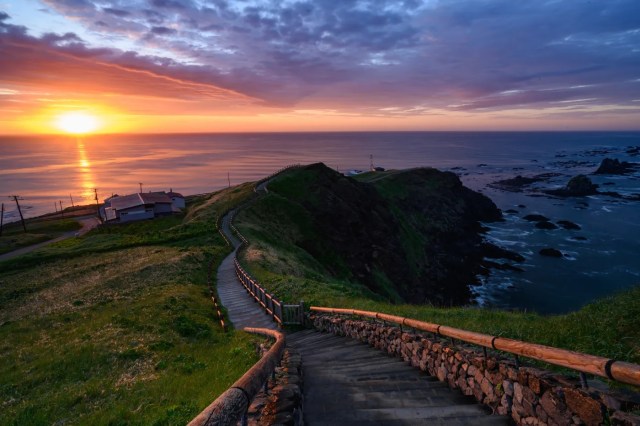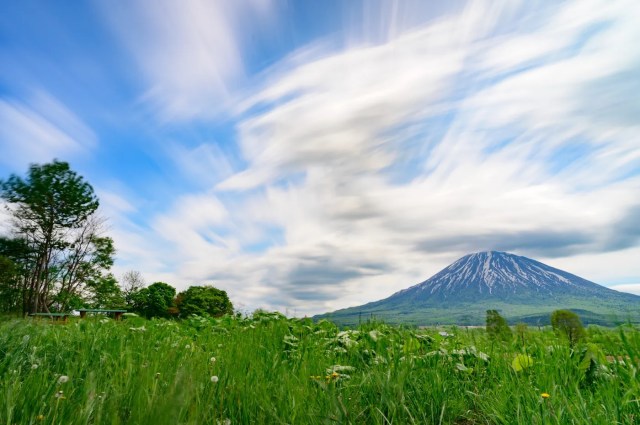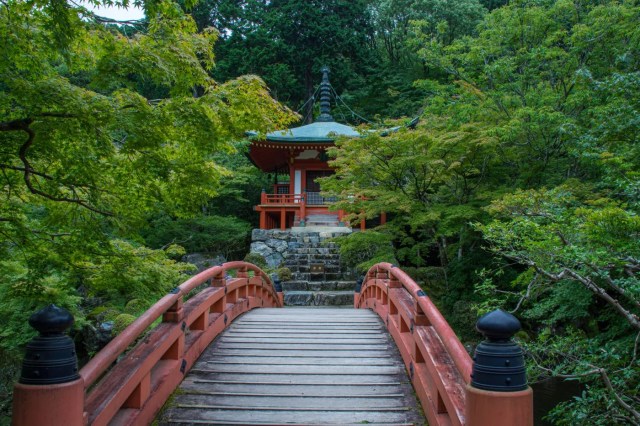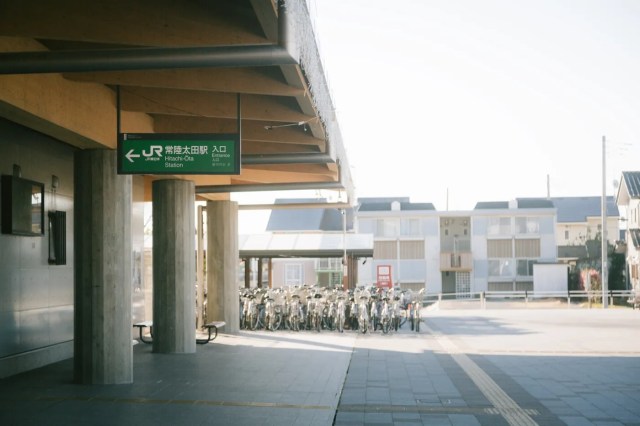
Prefectures at the bottom might not be as bad as the numbers make them seem, though.
On a map of the world, Japan looks like a pretty tiny place. Zoom in to a map of just Japan, though, and you’ll see that it has 47 different prefectures, and every year Japan’s Brand Research Institute conducts a survey asking respondents to rate the attractiveness of Japan’s prefectures.
To clarify, the survey isn’t about which prefecture has good-looking people, but which prefectures people in Japan have good feelings about. After tallying the responses from roughly 35,000 participants, last week this year’s results were announced, and at the top of the rankings is Hokkaido, Japan’s northernmost prefecture.
▼ Hokkaido’s Mt. Shiribeshiyama (and that’s the town of Erimo, on the Hokkaido coast, at the top of this article)
Hokkaido also finished first in the survey last year, and in fact it’s had the top spot for 13 years in a row now, ever since the first time the survey was held back in 2009. Meanwhile, all the way down at the opposite end of the list is Ibaraki. The attractiveness survey has never been kind to the eastern coastal survey. Last year it finished in 42nd place, which was actually cause for celebration after seven consecutive years before that in 47th, but in the latest survey it’s once again back at the bottom.
Following Hokkaido in the top five are Kyoto, Okinawa, Tokyo, and Osaka, in that order, all of which kept their positions from last year with the exception of Osaka, which moved up from sixth place and swapped positions with Kanagawa. It’s not hard to imagine why they all did well. Hokkaido has stunning mountain scenery and mild summers, while Okinawa boasts beautiful beaches and warm winters. Kyoto has its elegant cultural pedigree and temple architecture, and Tokyo and Osaka are the two most bustling cities in the country, filled with all sorts of contemporary entertainment options. They’re all known for delicious food, too, such as Hokkaido’s crab, Okinawa soki soba noodles, Kyoto yudofu tofu hot pot, Osaka takoyaki, and Tokyo’s unparalleled restaurant variety.
▼ Kyoto’s Daigoji Temple
There’s decidedly less glamour and gourmet appeal at the other end of the list, which consisted of:
42 (tie). Yamaguchi
42 (tie). Tokushima
44. Gunma
45. Saitama
46. Saga
47. Ibaraki
However, calling those the least attractive prefectures in Japan is giving them a bum rap, because the formula used to determine the rankings is sort of strange.
Survey participants were asked to select how they felt about each of Japan’s prefectures, with their options being “very attractive,” “moderately attractive,” “neither attractive nor unattractive,” “not very attractive,” or “completely unattractive.” If a prefecture was listed as “very attractive” it was awarded 100 points, and for “moderately attractive” it got 50 points. All other responses were worth zero points, and the survey’s final rankings were determined by the average number of points each prefecture received from respondents.
Since the survey doesn’t account for any difference between indifference and dislike, the prefectures at the bottom of the list might not necessarily be there because people think they’re bad places so much as because they don’t have well-known characteristics that make them stick out in people’s minds. Many of them lack claim-to-fame foodstuffs, and while they all have their own charms, several of them are overshadowed by their neighbors. Saitama’s cities aren’t as big and bright as Tokyo’s. Gunma’s mountains are beautiful, but many travelers go right past them and head to Nagano’s Japan alps. Yamaguchi sits between Hiroshima and Fukuoka, both of which have more numerous sightseeing attractions and easier transportation access.
▼ This non-descript shot of Ibaraki’s Hitachi Ota Station also works as a visual metaphor for many survey respondents’ perception of the prefecture.
So really, Ibaraki continuing to finish last on the list shouldn’t be taken as a sign that it’s the most unpleasant or dull part of Japan, just that it’s one that most people don’t have a specific pre-existing positive mental image of, even though this time of year is a great time to visit the prefecture.
Source: Brand Research Institute via NHK News Web via Jin
Top image: Pakutaso
Insert images: Pakutaso (1, 2, 3)
● Want to hear about SoraNews24’s latest articles as soon as they’re published? Follow us on Facebook and Twitter!




 When do Japanese women have their first kiss? Survey finds gap between different parts of Japan
When do Japanese women have their first kiss? Survey finds gap between different parts of Japan Kansai area people more genetically predisposed to liking coffee than elsewhere in Japan
Kansai area people more genetically predisposed to liking coffee than elsewhere in Japan Online survey sheds light on prefectural personality rankings of Japanese people
Online survey sheds light on prefectural personality rankings of Japanese people Top five Japanese prefectures for childhood education expenditure would make any wallet shudder
Top five Japanese prefectures for childhood education expenditure would make any wallet shudder Japan’s top 10 cat names for 2017
Japan’s top 10 cat names for 2017 New Nintendo Lego kit is a beautiful piece of moving pixel art of Mario and Yoshi【Photos】
New Nintendo Lego kit is a beautiful piece of moving pixel art of Mario and Yoshi【Photos】 How to order snacks on a Shinkansen bullet train in Japan
How to order snacks on a Shinkansen bullet train in Japan Hello, cosmetics! Clinique teams up with Hello Kitty this summer for first-time collaboration
Hello, cosmetics! Clinique teams up with Hello Kitty this summer for first-time collaboration Demon Slayer: Kimetsu no Yaiba gets new roller coaster attractions and food at Universal Studios Japan
Demon Slayer: Kimetsu no Yaiba gets new roller coaster attractions and food at Universal Studios Japan McDonald’s adds new watermelon frappe and fruity macaron to its menu in Japan
McDonald’s adds new watermelon frappe and fruity macaron to its menu in Japan Cosmetic wizardry: Asian women removing makeup to reveal their true selves goes viral【Video】
Cosmetic wizardry: Asian women removing makeup to reveal their true selves goes viral【Video】 Tsukiji Fish Market Vendor Releases Tuna For Home Assembly
Tsukiji Fish Market Vendor Releases Tuna For Home Assembly High-fashion Totoro cuddle purse is like an elegant stroll in the forest【Photos】
High-fashion Totoro cuddle purse is like an elegant stroll in the forest【Photos】 U.S. Olympic athlete reveals he runs with Yi-Gi-Oh! cards tucked into his uniform【Video】
U.S. Olympic athlete reveals he runs with Yi-Gi-Oh! cards tucked into his uniform【Video】 Japan’s new difficult-to-drink-from beer glass protects your liver, but it’s a brutal experience
Japan’s new difficult-to-drink-from beer glass protects your liver, but it’s a brutal experience Nintendo history you can feel – Super NES, N64, and GameCube controllers become capsule toys
Nintendo history you can feel – Super NES, N64, and GameCube controllers become capsule toys “The most Delicious Cup Noodle in history” – Japan’s French Cup Noodle wins our heart【Taste test】
“The most Delicious Cup Noodle in history” – Japan’s French Cup Noodle wins our heart【Taste test】 Starbucks releases a cute Frappuccino and Unicorn Cake…but not in Japan
Starbucks releases a cute Frappuccino and Unicorn Cake…but not in Japan Kyoto Tower mascot termination reveals dark side behind cute Japanese characters
Kyoto Tower mascot termination reveals dark side behind cute Japanese characters McDonald’s Japan’s Soft Twist Tower: A phantom ice cream only sold at select branches
McDonald’s Japan’s Soft Twist Tower: A phantom ice cream only sold at select branches Yabai Ramen: What makes this Japanese ramen so dangerous?
Yabai Ramen: What makes this Japanese ramen so dangerous? Finally! Nintendo Japan expands Switch 8-bit controller sales to everybody, Online member or not
Finally! Nintendo Japan expands Switch 8-bit controller sales to everybody, Online member or not Japanese government wants to build luxury resorts in all national parks for foreign tourists
Japanese government wants to build luxury resorts in all national parks for foreign tourists To combat declining birth rate, Japan to begin offering “Breeding Visas” to foreigners
To combat declining birth rate, Japan to begin offering “Breeding Visas” to foreigners 10 things you should buy at 7-Eleven in Japan
10 things you should buy at 7-Eleven in Japan Studio Ghibli releases anime heroine cosplay dresses that are super comfy to wear
Studio Ghibli releases anime heroine cosplay dresses that are super comfy to wear Woman charged for driving suitcase without a license in Osaka
Woman charged for driving suitcase without a license in Osaka Studio Ghibli unveils My Neighbour Totoro miniature house model
Studio Ghibli unveils My Neighbour Totoro miniature house model Kyoto experiencing problems with foreign tourists not paying for bus fares, but not on purpose
Kyoto experiencing problems with foreign tourists not paying for bus fares, but not on purpose Fighting mild hunger with a Japanese soda that turns into jelly in the stomach【Taste test】
Fighting mild hunger with a Japanese soda that turns into jelly in the stomach【Taste test】 Studio Ghibli’s Howl’s Moving Castle tapestry unveiled in Japan for first time
Studio Ghibli’s Howl’s Moving Castle tapestry unveiled in Japan for first time McDonald’s new Happy Meals offer up cute and practical Sanrio lifestyle goods
McDonald’s new Happy Meals offer up cute and practical Sanrio lifestyle goods Sales of Japan’s most convenient train ticket/shopping payment cards suspended indefinitely
Sales of Japan’s most convenient train ticket/shopping payment cards suspended indefinitely Sold-out Studio Ghibli desktop humidifiers are back so Totoro can help you through the dry season
Sold-out Studio Ghibli desktop humidifiers are back so Totoro can help you through the dry season Japanese government to make first change to romanization spelling rules since the 1950s
Japanese government to make first change to romanization spelling rules since the 1950s Foreigner’s request for help in Tokyo makes us sad for the state of society
Foreigner’s request for help in Tokyo makes us sad for the state of society Ghibli founders Toshio Suzuki and Hayao Miyazaki contribute to Japanese whisky Totoro label design
Ghibli founders Toshio Suzuki and Hayao Miyazaki contribute to Japanese whisky Totoro label design Doraemon found buried at sea as scene from 1993 anime becomes real life【Photos】
Doraemon found buried at sea as scene from 1993 anime becomes real life【Photos】 Tokyo’s most famous Starbucks is closed
Tokyo’s most famous Starbucks is closed Princesses, fruits, and blacksmiths: Study reveals the 30 most unusual family names in Japan
Princesses, fruits, and blacksmiths: Study reveals the 30 most unusual family names in Japan Get lucky: Survey polls Japanese women about their one-night-only amorous affairs in satin sheets
Get lucky: Survey polls Japanese women about their one-night-only amorous affairs in satin sheets Which prefecture has the most chilled young people? Survey asks 20 year olds “what are you worried about?”
Which prefecture has the most chilled young people? Survey asks 20 year olds “what are you worried about?” Japanese breast size study shows rapid growth in previously smallest-busted region of county
Japanese breast size study shows rapid growth in previously smallest-busted region of county The top 10 universities in Japan determined by 2021 World University Rankings
The top 10 universities in Japan determined by 2021 World University Rankings Going thin on top? Here are five prefectures you may not want to live in (and five you might!)
Going thin on top? Here are five prefectures you may not want to live in (and five you might!) What part of Japan has the best food, and what should you eat there?
What part of Japan has the best food, and what should you eat there? Japanese survey ranks Hokkaido as the most desirable prefecture to settle down in
Japanese survey ranks Hokkaido as the most desirable prefecture to settle down in What’s the top country people want to visit after the pandemic? Japan, survey says
What’s the top country people want to visit after the pandemic? Japan, survey says Terrific Tochigi! Japanese prefecture proves its beauty with scenery showcase【Video】
Terrific Tochigi! Japanese prefecture proves its beauty with scenery showcase【Video】 Is roughly half of Japan preconditioned to hate mint chocolate sweets?
Is roughly half of Japan preconditioned to hate mint chocolate sweets? Japanese constipation survey reveals the most and least poop-frustrated prefectures
Japanese constipation survey reveals the most and least poop-frustrated prefectures How should a guy say “I” in Japanese? Japanese women give their opinions【Survey】
How should a guy say “I” in Japanese? Japanese women give their opinions【Survey】 Survey ranks Japanese prefectures by how much people want to continue living there
Survey ranks Japanese prefectures by how much people want to continue living there Prefectural rivalry in Japan: Survey reveals which areas compete against each other, and why
Prefectural rivalry in Japan: Survey reveals which areas compete against each other, and why The number 1 ‘most satisfying’ city in the world is….TOKYO!!!
The number 1 ‘most satisfying’ city in the world is….TOKYO!!! 100 things to do in Japan in 100 seconds 【Video】
100 things to do in Japan in 100 seconds 【Video】
Leave a Reply